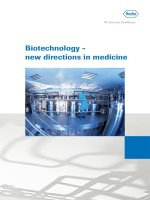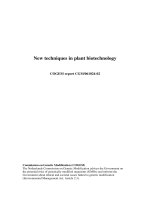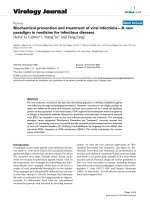Biotechnology new ways in medicine
Bạn đang xem bản rút gọn của tài liệu. Xem và tải ngay bản đầy đủ của tài liệu tại đây (4.16 MB, 68 trang )
Biotechnology -
new directions in medicine
We Innovate Healthcare
Biotechnology – new directions in medicine
Cover picture
T
he Roche Group, including Genentech in the United States and Chugai in
Japan, is a world leader in biotechnology, with biotech production facilities
around the globe. The cover photo shows a bioreactor at Roche’s Penzberg
facility and conveys at least a rough of idea of the sophisticated technical
know-how and years of experience required to manufacture biopharma-
ceuticals.
Published by
F. Hoffmann-La Roche Ltd
Corporate Communications
CH-4070 Basel, Switzerland
© 2006
Second, revised edition
Any part of this work may be r
epr
oduced, but the sour
ce should be cited in full.
All trademarks mentioned enjoy legal protection.
This brochure is published in German (original language) and English.
Reported fr
om:
Mathias Brüggemeier
English translation: David Playfair
Layout: Atelier Urs & Thomas Dillier, Basel
Printers: Gissler Druck AG, Allschwil
7 000 728-1
Content
Foreword
Progress via knowledge
5
Beer for Babylon 7
Drugs from the
fermenter
25
Main avenues of research 39
T
r
eatment begins
with diagnosis
51
Progress via knowledge
Over the past few decades biotechnology – sometimes described
as the oldest profession in the world – has evolved into a mod-
ern technology without which medical progress would be
scarcely imaginable. Modern biotechnology plays a crucial role
both in the elucidation of the molecular causes of disease and in
the development of new diagnostic methods and better target-
ed drugs.
These developments have led to the birth of a new economic sec-
tor, the biotech industry, associated mostly with small start-up
companies. For their part, the more established healthcare com-
panies have also been employing these modern techniques,
known collectively as biotechnology, successfully for many
years. By studying the molecular foundations of diseases they
have developed more specific ways of combating diseases than
ever before. This new knowledge permits novel approaches to
treatment, with new classes of drug – biopharmaceuticals – at-
tacking previously unknown targets. Increasing attention is also
being paid to differences between individual patients, with the
result that in the case of many diseases the goal of knowing in
advance whether and how a particular treatment will work in a
given patient is now within reach. For some patients this dream
has already become reality.
Diagnosis and treatment are thus becoming increasingly inter-
twined. When a disease, rather than being diagnosed on the ba-
sis of more or less vague signs and symptoms, can be detected
on the basis of molecular information, the possibility of suc-
cessful treatment depends largely on what diagnostic techniques
are available. To the healthcare industry this represents a major
development in that diagnosis and treatment are growing ever
closer together, with clear benefits for companies that possess
competence in both these areas. To patients, progress in medical
biotechnology means one thing above all: more specific, safer
and more successful treatment of their illnesses. To the health-
care industry it represents both an opportunity and a challenge.
F
or example, more than 40% of the sales of Roche’s ten best-sell-
ing pharmaceutical products are currently accounted for by bio-
p
har
ma
c
euticals, and this figure is rising.
This booklet is intended to show what has already been achieved
via close cooperation between basic biological research, applied
science and biotechnologically based pharmaceutical and diag-
nostic development.
5
Beer for Babylon
For thousands of years human beings
have used microorganisms to make
products – and in so doing have
practised biotechnology. Just as in
the past the development of beer,
bread and cheese were major
br
eakthroughs, another r
ev
olution is
now about to overtake medicine:
compounds pr
oduced using
biotechnological methods are
opening up entirely new possibilities
in medical diagnostics and therapy,
and in so doing are bringing about a
major restructuring of markets.
8
Babylonian biotechnologists were a highly regarded lot. Their
products were in demand among kings and slaves and were ex-
ported as far as Egypt. They are even mentioned in the Epic of
Gilgamesh, the world’s oldest literary work – the Babylonian
brewers, with their 20 different types of beer. Their knowledge
was based on a biological technology that was already thousands
of years old – fermentation
by yeast.
Though it may sound
strange, the brewing of beer
is an example of biotechnol-
ogy. Likewise, so is the bak-
ing of bread. Wine, yogurt,
cheese, sauerkraut and vine-
gar are all biotechnological
products. Biotechnology is
practised wherever biologi-
cal processes are used to produce something, whether Babylo-
nian beers or monoclonal antibodies. The only thing that is
relatively new about the biotechnology industry is its name.
The term ‘biotechnology’ was first used in a 1919
publication by Karl Ereky, a Hungarian engineer
and economist. He foresaw an age of biochemis-
t
ry that would be comparable to the Stone Age and the Iron Age
in terms of its historical significance. For him, science was part
o
f
an al
l-e
mbracing economic theory: in combination with po-
litical measures such as land reform, the new techniques would
provide adequate food for the rapidly growing world population
– an approach that is just as relevant today as it was in the pe-
riod after the First World War.
Stone Age, Iron Age,
Age of Biochemistry
5000 –2000 BC
Fermentation processes are used in
Egypt, Babylon and China to make
bread, wine and beer. Wall painting
from an Egyptian tomb built during
t
he Fifth Dynasty (c. 2400 BC).
500 BC
The antibiotic effect of tofu mould
cultures is discovered and used for
therapeutic purposes in China.
From knowledge to science: the history of biotechnology
Terms
Biopharmaceuticals
drugs manufactured using biotech-
nological methods.
DNA deoxyribonucleic acid; the chemical substance that
makes up our genetic material.
Genes functional segments of our genetic material that serve
mostly as blueprints for the synthesis of proteins.
Genome the totality of the DNA of an or
ganism.
Gene technology scientific work with and on the genetic
material DNA.
Recombinant proteins proteins obtained by recombining
DNA, e.g. by introducing human genes into bacterial cells.
Beer for Babylon 9
Ereky’s vision is all the more astonishing given that at that time
the most important tools of modern biotechnology were yet to
be discovered. Until well into the second half of the 20th century
biologists worked in essentially the same way as their Babylo-
AD 100
Ground chrysanthemum seeds are
used as an insecticide in China.
800 –1400
Artificial insemination and fertilisation
techniques for animals and plants
improve reproduction rates and yields
in the Middle East, Europe and China.
1595
H
ans Janssen, a spectacle maker,
b
uilds the first microscope.
© Rijksmuseum van Oudheden, Leiden, The Netherlands
10
nian predecessors: They used the natural processes that occur in
cells and extracts of plants, animals and microorganisms to pro-
duce the greatest possible yield of a given product by carefully
controlling reaction conditions.
Thanks to newly developed methods, however, the biotechnol-
ogy of the 20th century was able to produce a far greater range
of such natural products and at far higher levels of purity
and quality. This was due to a series of discoveries that permit-
ted the increasingly rapid development of new scientific tech-
niques:
❚ In the first half of the 19th century scientists discovered the
basic chemical properties of proteins and isolated the first
enzymes. Over the following decades the role of these sub-
stances as biological catalysts was elucidated and exploited
for research and development.
❚ The development of ever more sophisticated microscopes
rendered the form and contents of cells visible and showed
the importance of cells as the smallest units of life on Earth.
Louis Pasteur postulated the existence of microorganisms
and believed them to be responsible for most of the fermen-
tation processes that had been known for thousands of years.
This was the birth of microbiology as a science.
❚ From 1859 Charles Darwin’s theory of evolution revolution-
ised biology and set in train a social movement that led ul-
timately to a new perception of mankind. For the first time
the common features of and differences between the Earth’s
organisms could be explained in biological terms. As a result,
biology changed from a descriptive to a more experimental
scientific discipline.
❚ The rediscovery of the works of Gregor Mendel at the end
o
f
the 19th c
e
ntury ushered in the age of classical genetics.
Knowledge of the mechanisms of inheritance permitted
targeted interventions. Cultivation and breeding techniques
that had been used for thousands of years now had a scien-
tific foundation and could be further developed.
C. 1830
T
he chemical nature of proteins is
d
iscovered and enzymes are isolated.
C. 1850
T
he cell is identified as the smallest
i
ndependent unit of life.
1665
E
xamining a thin slice of cork under
t
he microscope, Robert Hooke discov-
e
rs rectangular structures which he
n
ames ‘cells’. Two years later Antoni
v
an Leeuwenhoek becomes the first
p
erson to see bacterial cells.
Beer for Babylon 11
These developments changed the face of biochemistry and bio-
technology. In addition to the classical, mostly agricultural,
products, more and more new products entered the market-
place. Enzymes were isolated in highly purified form and made
available for a wide variety of tasks, from producing washing
powder to measuring blood glucose. Standardised biochemical
test methods made their entrance into medical diagnostics and
for the first time provided physicians with molecular measuring
instruments. The structures and actions of many biomolecules
were elucidated and the biochemical foundations of life thereby
made more transparent. Biochemistry progressed from basic re-
search to a field of development.
However, it was only with the advent of gene tech-
nology that biology and biotechnology really
took off. From 1953, when James Watson and
Francis Crick presented the double helix model of DNA, work
on and with human genetic material took on the attributes of a
scientific race. As more was discovered about the structure of
DNA and the mechanisms of its action, replication and repair,
more ways of intervening in these processes presented them-
selves to researchers. Desired changes in the genetic makeup of
a species that previously would have required decades of system-
atic breeding and selection could now be induced within a few
months.
For example, newly developed techniques made it possible to in-
sert foreign genes into an organism. This opened up the revolu-
t
ionary possibility of industrial-scale production of medically
important biomolecules of whatever origin from bacterial cells.
T
he fir
st me
dicine t
o be produced in this way was the hormone
insulin: in the late 1970s Genentech, an American company, de-
veloped a technique for producing human insulin in bacterial
cells and licensed the technique to the pharmaceutical company
Eli Lilly. Hundreds of millions of diabetics worldwide have ben-
Gene technology spurs
innovation
1859
C
harles Darwin publishes his
r
evolutionary theory of evolution.
1866
T
he Augustinian monk Gregor Mendel
d
iscovers the rules governing the
i
nheritance of traits in peas. It will be
3
5 years before his work receives the
r
ecognition it deserves and lays the
f
oundations of modern genetics.
1869
F
riedrich Miescher, working in
T
übingen, isolates a substance from
w
hite blood cells in purulent
b
andages that he refers to as ‘nuclein’.
H
is description leads later to use
o
f the term ‘nucleic acids’.
12
1879
W
alther Fleming describes the
‘
chromatin’ present in cell nuclei; this
w
ill later be identified as DNA.
1913
I
n studies on the fruit fly
D
rosophila
m
elanogaster
,
Thomas Hunt Morgan
d
iscovers more rules of inheritance.
1878
W
hile searching for the organism
r
esponsible for anthrax, Robert Koch
d
evelops techniques for the cultivation
o
f bacteria that are still used today.
In 1982 human insulin became the world’s first biotechnolog-
ically manufactured medicine. This hormone plays a central
role in glucose metabolism in the body. In diabetics the body
either has lost the ability to pr
oduce insulin in sufficient quan-
tity (type 1 diabetes) or else no longer r
esponds adequately
to the hormone (type 2 diabetes). All people with type 1 dia-
betes and most people with type 2 diabetes r
equire regular
doses of exogenous insulin.
Until 1982 insulin was isolated from the pancreas of
slaughter
ed animals via a complex and expensiv
e process –
up to 100 pig pancreases being required per diabetic patient
per y
ear
. In its day
, this classical biotechnological method it
-
self represented a major medical breakthrough: until 1922,
when medical scientists discov
ered the effect of pancreatic
extracts, a diagnosis of type 1 diabetes was tantamount to a
death sentence. The hormone obtained from cattle and pigs
differs little from the human hormone. However, some patients
treated with it develop dangerous allergic reactions.
In 1978 the biotech company Genentech developed a method
of producing human insulin in bacterial cells. Small rings of
DNA (plasmids), each containing part of the gene for the
human hormone, wer
e inserted into strains of
Escherichia coli.
The bacteria then pr
oduced one or the other of the two insu-
lin chains. These were then separately isolated, combined and
finally conv
erted enzymatically into active insulin. The pharma-
ceutical company Eli Lilly acquir
ed an exclusiv
e licence for this
method from Genentech and introduced the medicine in 1982
in the U
SA and later worldwide – thus firing the starting gun
for medical biotechnology.
Some 200 million diabetics worldwide now benefit fr
om the
production of human insulin. Without gene technology and
biotechnology this would be impossible: in or
der to meet cur-
rent demands using pancreatic extract, around 20 billion pigs
would have to be slaughtered annually.
G
ene technology: human insulin from bacteria
Beer for Babylon 13
efited from this, the first biotechnologically manufactured med-
icine, since its introduction in 1982 (see box, p. 12).
This technology laid the foundation for a new in-
dustry. The early start-up biotech companies
joined forces with large, established pharmaceu-
tical companies; these in turn used biotechnology to develop
high-molecular-weight medicines.
In the early 1980s very few companies recognised
the medical potential of the rapidly expanding
field of biotechnology. One such visionary com-
pany was Genentech. This company, which can lay claim to
being a founder of the modern biotech industry, was formed in
1976 by Herbert Boyer, a scientist, and Robert Swanson, an en-
trepreneur, at a time when biochemistry was still firmly ground-
ed in basic research. However, Genentech did not remain alone
for long. From the late 1970s, and even more after the introduc-
tion of recombinant human insulin, more and more companies
that aimed to exploit the scientific success of gene technology
for the purposes of medical research and development were
formed, especially in the USA. Even today, nine of the ten
biggest companies devoted purely to biotechnology are based in
the USA (see box, p. 16).
At first these young companies worked in the shadow of the
pharmaceutical giants. This was true both in relation to sales
and number of companies and also in relation to public profile.
The situation changed abruptly, however, when biotech prod-
uc
ts a
c
hie
ved their first commercial successes. In the 1990s pro-
gress in gene technological and biotechnological research and
development led to a veritable boom in the biotech sector.
Within a few years thousands of new biotech companies sprang
up all over the world. Many of these were offshoots of public or
Rapid expansion
and stock market boom
1919
K
arl Ereky, a Hungarian engineer,
c
oins the term ‘biotechnology’.
1922
F
rederick Banting, Charles Best
a
nd James Collip observe the
b
eneficial effect of a pancreatic
e
xtract on diabetes; the hormone
i
nsulin is discovered.
1928
A
lexander Fleming discovers the
a
ntibiotic effect of penicillin.
A new economic
sector arises
14
private research institutes whose scientists hoped to obtain
financial benefit from their findings. Fuelled by expectations of
enormous future profits, the burgeoning biotechnology indus-
try became, together with information technology, one of the
driving forces behind the stock market boom of the final years
of the 20th century.
Measured on the basis of their stock market value alone, many
young biotech companies
with a couple of dozen em-
ployees were worth more at
that time than some estab-
lished drug companies with
annual sales running into
hundred of millions of
dollars. While this ‘investor
exuberance’ was no doubt
excessive, it was also essen-
tial for most of the start-ups
that benefited from it. For
the development of a new
drug up to the regulatory
approval stage is not only
extremely lengthy, but also risky and hugely expensive. The
main reason for this is the high proportion of failures: only one
in every 100,000 to 200,000 chemically synthesised molecules
makes it all the way from the test tube to the pharmacy.
Biotechnological production permits the manufacture of com-
plex molecules that have a better chance of making it to the mar-
k
et. On the other hand, biotechnological production of drugs is
more technically demanding and consequently more expensive
than simple c
he
mical synthesis.
W
ithout the money generated
by this stock market success, scarcely any young biotech com-
pany could have shouldered these financial risks.
For this reason many smaller biotech companies – just like Gen-
entech in 1982 – are dependent on alliances with major drug
1953
O
n the basis of Rosalind Franklin’s
x
-ray crystallographic analyses, James
W
atson and Francis Crick publish a
m
odel of the genetic substance DNA.
From 1961
V
arious researchers unravel the
g
enetic code.
1944
O
swald Avery, Colin MacLeod and
M
aclyn McCarthy identify DNA
a
s the chemical bearer of genetic
i
nformation.
This life-size bronze sculpture of Genentech’s founders
is on display at the company’s research centre in South
San Francisco.
Beer for Babylon 15
It took cour
age to found a biotechnology company in 1976.
At that time the business world considered the technology to
be insufficiently developed and the scientific world feared that
the search for financial rewards might endanger basic re-
search.Itwas scarcely surprising,therefore,that the respected
biologist Herbert Boy
er had intended to grant the young
venture capitalist Robert Swanson only ten minutes of his
time. Yet their conversation lasted three hours – and by the
time it ended the idea of Genentech had been born. Further
developments followed rapidly:
1976 On 7th April Robert Swanson and Herbert Boyer found-
ed Genentech.
1978 Genentech researchers produce human insulin in
cloned bacteria.
1980 Genentech shares are floated at a price of USD 35; an
hour later they have risen to USD 88.
1982 Human insulin becomes the first recombinant medicine
to be approved for use in the USA; the drug is marketed by
the pharmaceutical company Eli Lilly under licence from
Genentech.
1985 For the first time, a recombinant medicine produced by
a biotech company is approved for use: Protropin, produced
by Genentech (active ingredient: somatrem, a growth hor-
mone for children).
1986 Genentech licenses Roferon-A to Roche.
1990 Roche acquires a majority holding in Genentech and
by 1999 has acquired all the company’s shares.
1987–97 Major new drug approvals: Activase (1987; active
ingredient: alteplase, for dissolving blood clots in myocardial
infarction); Actimmune (1990; interferon gamma-1b, for use
in chronic immunodeficiency); Pulmozyme (1992; dornase
alfa, for use in asthma, cooperative project with Roche);
Nutropin (1993; somatropin, a growth hormone); Rituxan
(1997; rituximab, for use in non-Hodgkin’s lymphoma, coop-
erative project with Idec).
1998 The humanised monoclonal antibody Herceptin (tra-
stuzumab) is approved for use against a particular type of
br
east cancer.
1
9
99
Fortune magazine r
ates Genentech as one of the ‘hun
-
dr
ed best companies to work for in America’; Roche refloats
Genentech on the New York Stock Exchange (NYSE).
2002
The journal Science rates Genentech as the most popu-
lar employer in the field of biotechnology and pharmaceuticals.
2003–2004 Approval of Xolair (omalizumab, for use in
asthma); Raptiva (efalizumab, for use in psoriasis); Avastin
(bevacizumab, for the treatment of cancer).
1973
S
tanley Cohen and Herbert Boyer
u
se restriction enzymes and ligases to
r
ecombine DNA.
1975
G
eorges Köhler and César Milstein
p
ublish their method for the
p
roduction of monoclonal antibodies.
1976
H
erbert Boyer and Robert Swanson
f
ound Genentech, the first modern
b
iotechnology company.
The first modern biotechnology company: Genentech
16
c
ompanies or the services of contract manufacturers. As a result
of the changed stock market conditions after 2000 some of
these al
lianc
es e
v
olved into takeovers: the market value of most
biotech companies collapsed as abruptly as it had risen, and
access to additional capital via the stock market was mostly
impossible. The modern biotechnology sector is therefore now
in the middle of its first wave of consolidation.
1982
H
uman insulin becomes the first
m
edicine to be produced using gene
t
echnology, ushering in the age of
m
odern biotechnology.
1977
W
alter Gilbert, Allan Maxam and
F
rederic Sanger present their method
f
or sequencing DNA.
1983
K
ary Mullis and coworkers develop
t
he polymerase chain reaction (PCR).
1 Amgen (USA) 8360
2 Genentech (USA) 3300
3 Serono (Switzerland) 2000
4 Biogen Idec (USA) 1850
1
5 Chiron (USA) 1750
6 Genzyme (USA) 1570
7 MedImmune (USA) 1050
8 Invitrogen (USA) 780
9 Cephalon (USA) 710
10 Millenium (USA) 430
Source: company reports
1
comparative figure after the merger of Biogen and Idec in Nov.
2003
Many of the major healthcare companies are now also involved
in the biotech sector. If these too are taken into account, the
following picture emerges:
1 Amgen 7866
2 Roche Group including
Genentech and Chugai 6191
3 Johnson & Johnson 6100
4 Novo Nordisk 3561
5 Eli Lilly 3043
6 Aventis 2075
7 Wyeth 1870
8 Schering-Plough 1751
9 Serono 1623
10 Baxter International 1125
11 Biogen 1057
12 Schering AG 1035
13 Genzyme 879
14 MedImmune 780
15 GlaxoSmithKline 729
16 Bayer AG 563
17 Pfizer 481
18 Abbott Laboratories 397
19 Akzo Nobel 375
20 Kirin 355
Source: Evaluate Service
World’s largest biotech companies
by sales in 2003, in million USD
World’s largest healthcare companies by sales
of biotech products in 2003, in million USD
Beer for Babylon 17
This development did not, however, occur in
exactly the same way all over the world. Unlike its
counterpart in the USA,the European biotechnol-
ogy industry soon came to be dominated by established compa-
nies founded on classical biochemistry, chemistry and phar-
macology. The United Kingdom, Germany, France and
Scandinavia, in particular, have vibrant biotechnology sectors,
while Serono, the European market leader, is a Swiss company.
However the motors driving development in the world’s second
most important biotech region are derived almost exclusively
from the classical industrial sectors.
Boehringer Mannheim (BM) provides a good example of this
trend.As a supplier of laboratory equipment for use in biochem-
ical research and medical diagnostics, this German company
had possessed an abundance of expertise in developmental and
manufacturing processes for the biotechnology sector since its
very inception. As early as the 1940s BM had engaged in classi-
cal biotechnology, first in Tutzing and later in Penzberg, near
Munich (see box, p. 19). It made the transition to modern bio-
technology during the 1980s with the introduction of a number
of recombinant (i.e. genetically engineered) enzymes.
In 1990 BM introduced its first genetically engineered medicine,
NeoRecormon (active ingredient: erythropoietin, or EPO). In a
more recently developed form, this drug still plays an important
role in the treatment of anemia and in oncology. This makes it
one of the world’s top-selling genetically engineered medicines
– and an important source of income for the company, which
was integrated into the Roche Group in 1998.
R
o
c
he itse
lf has been a pioneer of biotechnology in Europe. Like
BM, Roche had had an active research and development pro-
gramme in both therapeutics and diagnostics for decades. It be-
gan large-scale production of recombinant enzymes as long ago
as the early 1980s. In 1986 it introduced its first genetically en-
From 1984
G
enetic fingerprinting revolutionises
f
orensics.
Europe: Pharma enters
the biotech sector
1994
T
he first genetically modified
t
omatoes are marketed in the USA.
1990
The Human Genome Project is
l
aunched; the German gene
t
echnology law is passed.
18
gineered medicine, Rofer-
on-A, containing interferon
alfa-2a. This product for use
against hairy cell leukemia
was manufactured under li-
cence from Genentech. After
its takeover of Boehringer
Mannheim, Roche devel-
oped the Penzberg site into
one of Europe’s biggest bio-
technology centres.
Following its acquisition of
a majority stake in Genen-
tech in 1990, Roche’s take-
over of BM was the Group’s
second major step into bio-
technology. Finally, its ac-
quisition of a majority stake
in the Japanese pharmaceu-
ticalandbiotechnology com-
pany
Chugai in 2002 put the
Roche Group close behind
the world market leader
Amgen in terms of biotech
sales.
Roche thus provides a good
example of the development
of European biotechnology.
I
ts competitors have fol-
lowed a similar course,
thoug
h in so
me cases lat
e
r
or with different focuses.
1997
F
or the first time a eukaryotic genome,
t
hat of baker’s yeast, is unravelled.
1998
T
he first human embryonic cell lines
a
re established.
2001
The first draft of the human genome is
published.
Beer for Babylon 19
2003
The sequencing of the human genome
is completed.
Research could scarcely be more picturesque: one of Eu-
rope’s biggest biotech sites is situated 40 kilometers south of
Munich at the foot of the Bavarian Alps. For over 50 years
researchers at Boehringer Mannheim, working first in Tutzing
and later in Penzberg, developed biochemical reagents for
biological research and medical diagnostics and therapy.
Since Roche took over BM in 1998, Penzberg has become
the Group’s biggest biotechnological research and produc-
tion site.
1946 Working with a small research group, Dr Fritz Engel-
horn, a departmental head at C. F. Boehringer & Söhne, under-
takes biochemical work in the former Hotel Simson in Tutzing.
1948 The amino acid mixtures ‘Dymal’, ‘Aminovit’ and ‘Lae-
vohepan’ become BM’s first biotechnologically produced
pharmaceuticals.
1955 Under the brand name ‘Biochemica Boehringer’,
BM supplies reagents for
research and enzyme-
based diagnostics through
-
out the world.
1968 The isolation of
polynucleotides launches
research into molecular
biology.
1972 BM acquires a dis-
used mining site in Penz-
berg and builds a new pro-
duction plant there for its
rapidlyexpanding biochem-
ical
and diagnostics prod-
uct lines.
1977 First work in gene
technology at Tutzing.
1980 Establishment of a
labor
atory for the produc-
tion of monoclonal anti-
bodies at Tutzing.
1981 Large-scale produc-
tion of recombinant en-
zymes begins at Penzberg.
1985 Roche is awarded German Industry’s Innovation Prize
for Reflotron, an analytical device for determining blood
parameters.
1986 Process development work for BM’s first recombinant
medicine, NeoRecormon (active ingredient: erythropoietin)
begins.
1990 NeoRecormon is approved for use in the treatment of
anemia.
1996 Rapilysin (active ingredient: tissue plasminogen activa-
tor, for the treatment of myocardial infarction) becomes the
first recombinant drug to be discovered, developed and pro-
duced in Germany.
1998 The Roche Group takes over BM; over the following
years Roche develops the Penzberg site into one of Europe’s
biggest and most modern biotechnology centres.
‘Big biotech’ at the foot of the Alps: Penzberg
20
Compared to their counterparts in Europe, the
p
har
ma
c
eutical companies of the various Asian
countries – which are otherwise so enthusiastic
about new technology – were slow to recognise the potential of
this new industrial sector. This despite the fact that the Japanese
pharmaceutical market is the world’s second largest, after that of
Japan: potential in
biotechnology
Roche’s line of biotechnological products dates back to the
1940s. The resulting expertise has paid off: The Roche Group
is now the world’s second largest biotechnology company
and has a broader product base than any of its biotech com-
petitors. Its three best-selling medicines are biopharmaceuti-
cals, and almost half the sales of its top ten pharmaceutical
products are accounted for by biopharmaceuticals. Roche’s
Diagnostics Division supplies over 1700 biotechnology-based
products. PCR technology alone generates annual sales of 1.1
billion Swiss francs. Key milestones on the way to this success
are listed below:
1896 Fritz Hoffmann-La Roche founds the pharmaceutical
factory F. Hoffmann-La Roche & Co. in Basel.
1933 Industrial production of vitamin C begins; within a few
years Roche becomes the world’s largest producer of vita-
mins.
1968 With its Diagnostics Division, Roche opens up a for-
ward-looking business segment; Roche establishes the
Roche Institute of Molecular Biology in Nutley, USA.
1971 The Basel Institute for Immunology is set up and fi-
nanced by Roche.
1976 Georges Köhler (a member of the Institute from 1976
to 1985) begins his work on monoclonal antibodies.
1980 Cooperation with Genentech begins; over the following
decades alliances with biotech companies become a central
feature of the Roche Group’s corporate philosophy.
1984 Niels Kaj Jerne and Georges Köhler of the Basel Insti-
tute for Immunology are awarded the Nobel Prize for Physiol-
ogy or Medicine jointly with César Milstein; their colleague
Susumu Tonegawa (a member of the Institute from 1971 to
1981) is awarded the Nobel Prize in 1987.
1986 The alliance with Genentech leads to the development
of Roferon-A (active ingredient: interferon alfa-2a), Roche’s
first genetically engineered drug; Roche introduces an HIV
test.
1991 Roche acquires worldwide marketing rights to the
polymerase chain reaction (PCR) from Cetus Corporation;
only two years later this technology forms the basis of the HIV
test Amplicor, the first PCR-based diagnostic test.
1992 Hivid, Roche’s first AIDS drug, is introduced.
1994 Roche takes over the US pharmaceutical company
Syntex and in 1995 converts it into Roche Biosciences.
1998 Roche takes over the Corange Group, to which Boeh-
ringer Mannheim belongs. Cooperation with deCODE genet-
ics begins.
1999 Following its complete takeover of Genentech, Roche
returns 42% of the company’s shares to the stock market; the
monoclonal antibody Herceptin is approved for use in breast
cancer.
2000 The Basel Institute for Immunology is transformed in-
to the Roche Center for
Medical Genomics.
2001 The merger of Nip-
pon Roche and Chugai
results in the formation of
Japan’s fifth largest phar-
maceutical manufacturer
and leading biotech com-
pany.
2002 Pegasys (active
ingredient: peginterferon
alfa-2a, for use against
hepatitis C) is approved
for use in Europe and the
USA; Roche sells its Vita-
mins and Fine Chemicals
Division to DSM.
2003 Cooperation with
Affymetrix on the pro-
duction of DNA chips
begins; AmpliChip CYP
450, the world’s first
pharmacogenomic medi-
cal diagnostics product,
is introduced.
2004
New biotechno-
logical
production plants
are built in Basel and
Penzberg.
No newcomer to biotech: the Roche Group
Beer for Babylon 21
the USA; in scarcely any other country are so many drugs pre-
scribed, an eighth of worldwide pharmaceutical sales being ac-
counted for by Japan alone. Moreover, two Japanese companies,
Takeda and Sankyo, rank among the 20 largest pharmaceutical
companies in the world.
In the 1990s Japan set out on the road to catch up, in particular
via large-scale support programmes and targeted alliances. The
result is that Japanese pharmaceutical companies are now at
least on a par with their counterparts in most European coun-
tries in terms of sales of biopharmaceutical products. However,
the country still lags behind in terms of the number of biotech
companies based there, the period of rapid expansion in the
1990s having largely passed Japan by. As yet, Japanese companies
devoted exclusively to modern biotechnology have an even
smaller slice of the world market than their European competi-
tors.
J
apanese b
iot
e
chnology is largely in the hands of representatives
of classical branches of industry such as the brewery Kirin, the
food manufacturer Takara, the chemical manufacturer Kyowa
Hakko and various pharmaceutical companies.The market lead-
er in modern biotechnology in Japan is Chugai Pharmaceutical
Number one in Japanese biotechnology: Chugai Pharma
When the Japanese set themselves a goal, their competitors
have a hard time of it. A few years ago the Japanese phar-
maceutical company Chugai set its sights on joining the first
rank of the world’s biotech companies. Since then it has been
catching up at an astonishing rate and is now at the top of the
Japanese market, at least. Since its merger with Nippon
Roche, Chugai has become not only the fifth largest pharma-
ceutical company, but also the largest modern biotechnology
company, in Japan. A brief chronology follows:
1925 Juzo Uyeno founds a small pharmaceutical
company in Tokyo that becomes increasingly impor-
tant nationally over the coming decades.
1986 The present-day company Chugai Pharma
Europe takes up headquarters in London.
1989 Chugai acquires Gen-Probe, an American bio-
tech company and diagnostics manufacturer.
1990 Epogin (active ingredient: erythropoietin, a
growth factor) becomes the first genetically engi-
neered drug produced by Chugai to be approved for
use in Japan.
1991 Granocyte (active ingredient: rHuG-CSF, for
promoting the growth of white blood cells) is approved for use
in Japan and later also in Europe, Australia and China.
1993–96 Chugai enters into a number of alliances for the
discovery, development and marketing of drugs.
1995 The Chugai Research Institute for Molecular Medicine
is founded.
1997 Chugai Diagnostics Science is f
ormed.
2002 Chugai and Nippon Roche merge to form Japan’s fifth
largest pharmaceutical company.
22
Co., Ltd., a company with an 80-year tradition and one of the
first companies in Japan to invest in gene technology.
Milestones along this company’s development in this area were
its acquisition of the American biotech company Gen-Probe in
1989 and, a year later, the granting of regulatory approval for its
first genetically engineered drug, Epogin (active ingredient:
erythropoietin, for use in anemia). Access to the worldwide
market for these products is provided by the Roche Group,
which acquired a majority stake in Chugai in 2002.
The merger between Nippon Roche, Roche’s Japanese subsidi-
ary, and Chugai in 2002 led to the formation of Japan’s fifth-
largest pharmaceutical company and largest biotech company.
Chugai operates as an independent member of the Roche Group
and is listed separately on the stock exchange. It is responsible
for the sale of all Roche products in Japan and also benefits from
the Group’s worldwide sales network; for its part, Roche has li-
censee rights to all Chugai products marketed outside of Japan
or South Korea.
As seen from the example of the Roche Group,
small, innovative biotech companies are increas-
ingly entering into alliances with big pharma-
ceutical companies. At the same time, the big
companies have expanded their portfolios by acquiring majori-
ty stakes in biotech companies listed separately on the stock
exchange and by entering into alliances in this area. And an im-
petus to change is arising from biotech companies themselves:
by engaging in takeovers and opening up new business seg-
ments, they too are investing beyond their established areas of
operation.
As a result of this development, most biotechnologically manu-
factured drugs are marketed by pharmaceutical companies. And
this trend is likely to become even more pronounced in the fu-
ture. Thus, Roche is currently the world’s second biggest sup-
plier of biotechnological products and, with more than 50 new
drug projects under way at present, has the world’s strongest
early development pipeline in this area. Aventis and Glaxo-
S
mithK
line,
ea
ch with 45 drug candidates, share second place in
this ranking. Amgen, currently the world’s largest biotech com-
pany, had about 40 drug candidates in the pipeline in 2004.
At the same time, worldwide growth in the biotechnology
market shows no sign of slackening. Thus, at present 40% of the
Prospects:
biotechnology in
transition
Beer for Babylon 23
sales of Roche’s ten best-selling pharmaceutical products are ac-
counted for by biopharmaceuticals, and this figure is rising. The
many young biotech companies with drug candidates now ap-
proaching regulatory approval are also banking on this growth.
Both in Europe and in the USA, many such companies formed
at the time of the stock market boom in biotechnology will soon
be marketing their first drug or drugs. Sales of these will support
their development pipelines – and thereby also intensify com-
petition in this field.
At present the world’s ten largest biotech companies account for
about 85% of the approximately 37 billion US dollars of sales of
biotechnological products worldwide. A comparison of the de-
velopment pipelines of the big companies with those of the gen-
erally smaller companies that are devoted exclusively to bio-
technology suggests that this concentration is likely to become
even greater in the coming years, though given the spectacular
growth rate of this sector, the possibility of surprises cannot be
ruled out. What is clear is that biotechnology has had a decisive
influence on the pharmaceutical market – and that the upheaval
is not yet at an end.
Works consulted and literature for further reading
Campbell NA, Reece JB: Biologie. Spektrum Akademischer Verlag, Heidelberg, 6th edition
2003
Stryer L: Biochemie. Spektrum Akademischer Verlag, Heidelberg, 4th edition 2003
Die Arzneimittelindustrie in Deutschland – Statistics 2004. VFA Verband Forschender
Arzneimittelhersteller e.V., editor, Berlin, August 2004
Presentations at a media conference: The Roche Group – one of the world’s leaders in
biotech, Basel, November 2004
/>Prowald K: 50 Jahre Biochemie und Biotechnologie bei Boehringer Mannheim. 50 Jahr
Feier, Evangelische Akademie Tutzing, 1966
Balaji K: Japanese Biotech: A Plan for the Future. Japan Inc., August 2003. See:
www.japaninc.net
bio.com – life on the net: www.bio.com
Genentech, Inc.: www.gene.com
Roche Group: www.roche.com
BioJapan: www.biojapan.de
Chugai Pharmaceutical Co., Ltd.: www.chugai-pharm.co.jp
Schmid RD: Pocket Guide to Biotechnology and Genetic Engineering. Wiley-VCH, Weinheim,
2002









